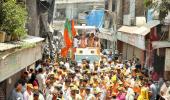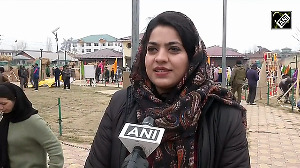'When there are no good roads and no buses plying to villages, your spending on development is skewed.'

The terrain of drought-prone Palghar, a seat reserved for scheduled tribes, is contrasting, and so are the demands.
While the tribal areas seek basic facilities, the burgeoning urban area, flush with new housing projects boasting proximity to the dream city, wants better frequency of the local train.
Palghar district sits at a juncture of major infrastructure development -- from the port to the aspirational bullet train (high-speed rail corridor connecting Mumbai to Ahmedabad). The government plans to build Vadhavan Port -- a major deepsea container port with over Rs 76,000 crore (Rs 760 billion) investment.
The greenfield port will be jointly developed by the Jawaharlal Nehru Port Authority and the Maharashtra Maritime Board. It has received clearance from the environment ministry, and an appeal in the Bombay high court upheld the permission to build it. The port remains a contentious factor when it comes to who the residents will vote for.
The villagers say that over 48 villages will be impacted. Though they have been assured that they will not be displaced, they argue that with over 150,000 trucks plying, the area will not remain suitable for residence and would need wider roads leading to the clearance of fauna and houses around.
They point to the environmental damage the port would cause.
"If we cut a single mangrove, a case is filed against us, while the government will remove the whole mangrove ecosystem. Is that not a violation?" questions a resident, while another says the government has not heeded their problems.

'
The electoral contest is between the Shiv Sena (UBT)'s Bharti Bharat Kamdi and the Bharatiya Janata Party's Hemant Savara.
The Palghar constituency has eight talukas and comprises six legislative assembly segments, namely Palghar, Dahanu, Vasai, Boisar, Nalasopara, and Vikramgad. According to the 2011 Census, the population was nearly 3 million, with over 54 per cent living in rural areas.
While the rural population is dependent on the produce of paddy, chikoo, and certain millets, the urban counterpart has grown in industrial presence with the help of the Maharashtra Industrial Development Corporation.
In Patel Pada, a village that falls on the route of the bullet train, residents say they have not benefited from schemes like Har Ghar Nal Yojana and are still dependent on community borewells and drying ponds. However, many are happy. They say that they have been compensated well for their land, which has been acquired -- almost five times the price.
Though only over 130 kilometres away from Mumbai, the road to Dahanu is no easy one.
It takes over three to four hours for the journey on a highway far from the glory of the ones appearing on the posters for the incumbent government's achievements.
"Bullet trains are no longer the issue for the election. At the ground level, the only issues are not having proper land records and bad blood within the families over the same land, says Brian Lobo, a resident of Palghar.
"More than land acquisition," says Lobo, "the question is about development priorities. When there are no good roads and no buses plying to villages, your spending on development is skewed."












 © 2025
© 2025